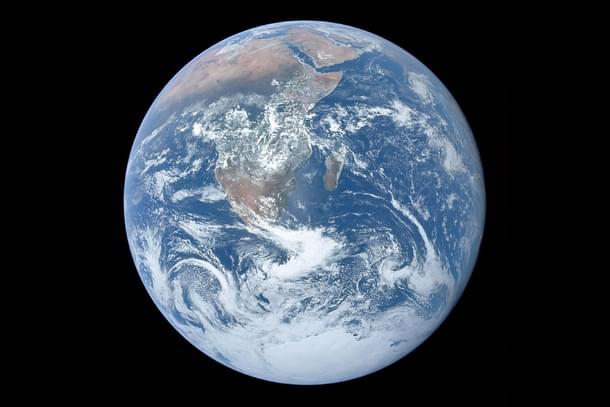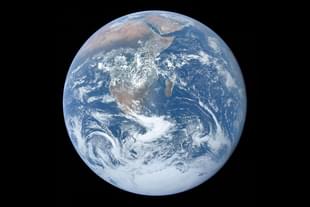Culture
Navratri Notes: Gaia—Ancient Mother Earth Reawakens In Science
Aravindan Neelakandan
Oct 08, 2024, 07:45 PM | Updated 07:45 PM IST
Save & read from anywhere!
Bookmark stories for easy access on any device or the Swarajya app.


She is the Mother of all beings. She is the nourishment and the home. She sustains life. She preserves life. She destroys the strayers. She maintains the balance. She is the cycles through which matter and energy flow. She is the planet. She is the processes of the planet. She is both allostasis and homeostasis.
She is Gaia – the ancient Goddess of the planet rediscovered in science.
Hesiod was a great Greek poet who lived around the time of Homer, 750 to 650 BCE. His work Theogony was about the origin of Gods and Goddesses of the Greek pantheon. It was in this work Gaia gets introduced as the Great Mother – Earth Herself.
She was self-created - an Autopoietic Goddess.
Historians of religion Christopher Fee and David Lamming write that the worship of Earth Mother was well attested millennia in the deep past of the Western heritage of humanity, with other Goddess streams enriching it:
Archaeological evidence in caves near Delphi indicates that an Earth Mother was worshipped there from prehistoric times, and by 1400 BCE, as the deity Gaia, she was the central focus of that worship. Gaia worship coincided roughly with the pre-eminence of the great snake goddess of Crete and the great goddesses of the Middle East.
Some other historians consider Gaia as reappearing of the Great Goddess worshipped in Minoan and Mycenaean culture, after they collapsed in 1200 BCE. After some four hundred years the Goddess reappeared in Greece as Gaia, an underlying reality in all walks of life.
Orpheus was the mythical divine musician who was also the good shepherd of ancient Greek mythology. He was a mythological being who descended into the realm of death and came back from death to life.
A collection of 87 hymns are attributed to him. Written in a Greek dialect called Homeric Greek, they sing of the Gods and Goddesses. The 26th of these hymns is for Gaia. In the Orphean mystery religion, with offering of grains other than beans and aromatic herbs, the following hymn is sung to Gaia:
Divine Earth,
Mother of all humans and Gods,
Nourishing all life, granting sustenance to all,
Endowed with fertility, yet
You are the force that destroys;
Parenting all, You gift us the seasons
With forms ever-changing, O Goddess!
Universe Indestructible abides in You,
Through the pains of labor, You bring forth fruits.
Deep-bosomed and blessed,
Your smile is the sweetness of grass in the breeze,
Your beauty, the flowers adorning the land,
Your happiness, the rains falling from above.
In Your glorious sky, celestial orbs
ceaselessly revolve.
Blessed Mother Earth, come!
Come, Mother!
Multiply the fruits of our labour!
Come, Mother!
Hear this heart-centred hymn in Your praise! (A free translation)
With the descent of Christianity Gaia lost Her Divine status. She was became a forsaken Goddess - just an exhibit in the museum of other 'false' gods.
But She came back.
When did Gaia reemerge in the West?
In recent centuries in the Western civilisation, alongside the rise of Enlightenment thought, there has been a subtle but potentially profound reawakening of the idea of the Earth as a living entity.
Here, one should remember that Enlightenment of Europe itself had many strands derived from deep Pagan philosophies of Neo-Plantonism to Hermetic mysticism. Spinoza, known for his highly rationalist and monist philosophy, envisioned the Divine Substance as present in all things, manifesting in countless forms.
While Spinoza’s universe was impersonal and logical, his core vision of concept of ‘Deus sive Natura’ (God or/is Nature) inadvertently aligns with an animistic view of nature—one that perceives the Earth as imbued with and manifestation of the Divine.
Ecologist-author Stephen Harding observes that by infusing nature with a monistic, divine essence, thinkers from Spinoza to Alfred North Whitehead echoed what could be described as a "primordial mode of perception"—a sense of a living, interconnected universe that can be more vividly experienced in Earth's dynamic processes. This idea also ties into the ancient concept of Anima Mundi—the World Soul—an idea central to Western thought since Plato, though often overshadowed by more mechanistic philosophies.
In science, when Darwin brought out the dynamic relation between environment and the evolution of life forms, a gateway was born for the reawakening of a planetary Goddess. It was then only a matter of time.
While on the one hand New Physics was speaking of an ecological entangled interconnected universe right from the microcosom, bio-physicist James Lovelock and microbiologist Lynn Margulis came with the Gaia hypothesis – that the earth through its evolutionary history has been a mega-regulatory system – a geo-bio interconnectedness in which life too acts as a process in planetary self-regulation.
Lovelock first had the notion of life as biosphere regulating the surface environment of the planet in 1965. In 1968, American Astronautical Society invited him to present the idea in a paper which was accepted and used to study atmosphere of the planets to see if they had life. Then in 1971 he started his collaboration with microbiologist Lynn Margulis.
Lynn brought ‘her deep understanding of microbiology’ and stressed ‘the importance of the Earth’s bacterial ecosystem and its being the fundamental infrastructure of the planet.’ In the words of Lovelock, Lynn put ‘flesh on the skeleton of Gaia.’
This paradigm shifting hypothesis needed a name. Gaia became the name. It was suggested to Lovelock by novelist William Golding.
There was extraordinary resistance from the scientific establishment to the hypothesis. One of the fiercest critics of Gaia was Richard Dawkins. Philosopher of biology Prof. Michael Ruse observes that ‘the disagreement over Gaia does not seem to have been just a matter of pure science’:
Indifference. Hostility. Rejection. Sneering. Outright condemnation. Papers blocked from publication and derision all around.
Robert May who would become the head of the Royal Society called Lovelock a ‘holy fool.’ Paul Ehrlich, American biologist openly stated that he hated Gaia and considered Lovelock ‘more radical and dangerous.’ John Postgate, another powerful microbiologist of the establishment called Gaia ‘“pseudoscientific myth-making.’
Lovelock painstakingly explained repeatedly that Gaia was a metaphor. To him it was ‘a shorthand for the hypothesis of the biosphere as ‘a self-regulating entity with the capacity to keep our planet healthy by controlling the chemical and physical environment.’’ Physicist always use metaphoric language – when they speak of quarks as having charm and colour and electrons having spin. But that does not make physics pseudoscience.
By 1980s and ‘90s, Gaia hypothesis, despite all the harsh treatment and obstacles, had become a theory. It has been debated by scientists, refined by constructive criticisms, validated and constantly modified by empirical data. But it has achieved much more throughout its journey, from facing hostile establishment resistance to gaining acceptance and respectability.
Lovelock stresses an important point here:
As the title of one article in Science put it, "No Longer Willful, Gaia Becomes Respectable." This means that Gaia scientists are constrained by bureaucratic forces, by the pressures of tenure, and by the tribal divisions and rules of scientific disciplines. That, in turn, means we need some antidote to the inevitable separations and constraints. We need independent synthesizers and visionaries who can make sense of the data produced by the scientific establishment and present it to us in ways that make our living planet real to us within the Gaian context and thus give meaning to our own lives and those of our children and grandchildren.
A rigorous scientist, Lovelock also points out how the ancient Goddess has unwittingly awakened, not through incantations this time, but through the visions of an interconnected planet revealed by science:
The concept of Mother Earth has been widely held throughout history and has been the basis of a belief which still coexists with the great religions. As a result of the accumulation of evidence about the natural environment and the growth of the science of ecology, there have recently been speculations that the biosphere may be more than just the complete range of all living things within their natural habitat of soil, sea, and air. Ancient belief and modern knowledge have fused emotionally in the awe with which astronauts with their own eyes and we by indirect vision have seen the Earth revealed in all its shining beauty against the deep darkness of space.
Lynn Margulis also points to the ancient intuitive archetypal Goddess imagery deep in our language itself, re-emerging with planetary ethical implications for our species:
Dghem’, however pronounced,... reminds us, is the ancient Indo-European term for ‘Mother Earth’. Surprisingly different English words derive from dghem. This fact illuminates... that we humans can lead happier, healthier, more knowledgeable and lively lives if we return to the ‘experience of Gaia as a living presence.’... (When you understand Gaia) you will know for yourself that what has been called ‘the Earth’s environment’ is no externality. The environment is part of the body.
Today Gaia is no longer a forgotten ancient Goddess in the West. She is alive. She is you and me; in the plants and the animals; in the bacteria and the mountains; in the viruses and the oceans. She is the Web. The Kaleidoscopic Web She reinvents Herself through lithosphere, atmosphere and hydrosphere. She is the biosphere. We the human species are the nano strands of the web that is Gaia.
In the vision of Gaia as in Her science, the innocent reverence of a Hindu child who says every morning before her feet touch the earth—"paada sparsham kshamasvame"—gets reaffirmed.
It is religion, it is science. It is poetry. It is planetary spirituality.
Also read:
1. Navratri notes: Nammu, the forgotten Serpent-Sea Goddess from Sumeria
2. Navratri notes: Inanna, the Goddess of Life and War
3. Navratri notes: Maat, the Goddess of Cosmic Order, Breath of Life, and Justice
4. Navratri notes: Artemis, The Goddess of Wild Life and Child Birth
5. Navratri notes: She flows like Ganga, Saraswati, and also like Oshun of the Yorubas of Africa





